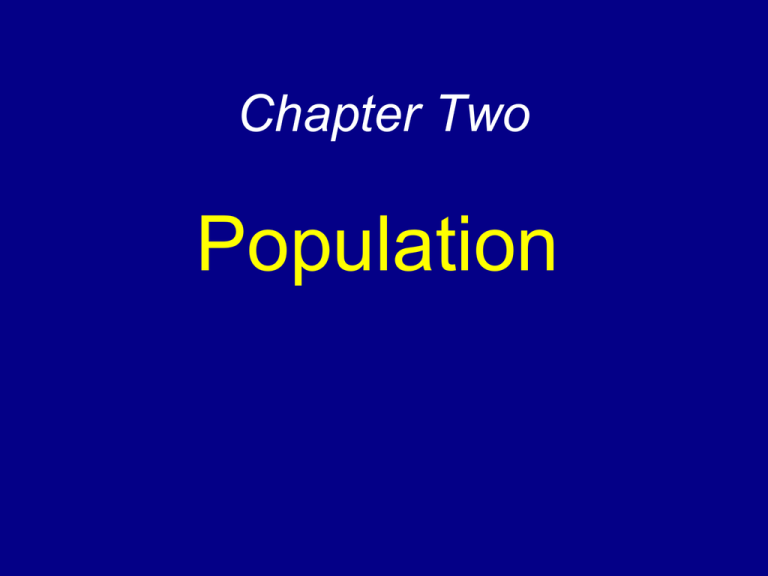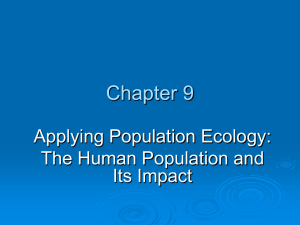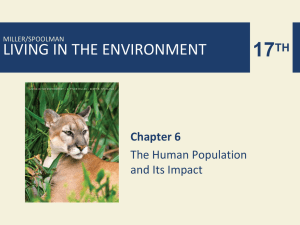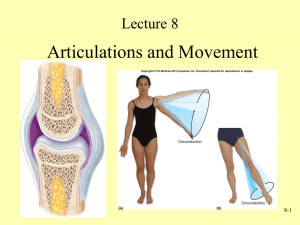
Chapter Two
Population
Distribution of World Population
• Population concentrations
– The four largest population clusters
– Other population clusters
• Sparsely populated regions
– Dry lands
– Wet lands
• Population density
– Arithmetic density
– Physiological density
– Agricultural density
– Cold lands
– High lands
World Population Cartogram
Fig. 2-1: This cartogram displays countries by the size of their population rather than
their land area. (Only countries with 50 million or more people are named.)
World
Population
Distribution
& Climate
Zones
Fig. 2-2: World population is unevenly distributed across the earth’s surface.
Climate is one factor that affects population density.
World Population Density
Climate Zones (simplified)
Expansion
of the
Ecumene
5000 BC AD 1900
Fig. 2-3: The ecumene, or the portion of the
earth with permanent human
settlement, has expanded to cover
most of the world’s land area.
Ecumene, 5000 B.C.
Ecumene, A.D. 1
Ecumene, A.D.1500
Ecumene, A.D.1900
Arithmetic Population Density
Fig. 2-4: Arithmetic population density is the number of people per total land area.
The highest densities are found in parts of Asia and Europe.
Physiological Density
Fig. 2-5: Physiological density is the number of people per arable land area. This
is a good measure of the relation between population and agricultural
resources in a society.
Measures of Population Density
Distribution of World
Population Growth
• Natural Increase
• Fertility
• Mortality
World Population Growth
1950 - 2005
Fig. 2-6: Total world population increased from 2.5 to over 6 billion in slightly over 50
years. The natural increase rate peaked in the early 1960s and has declined
since, but the number of people added each year did not peak until 1990.
Natural Increase Rates
Fig. 2-7: The natural increase rate (NIR) is the percentage growth or decline in the
population of a country per year (not including net migration). Countries in
Africa and Southwest Asia have the highest current rates, while Russia and
some European countries have negative rates.
Crude Birth Rates
Fig. 2-8: The crude birth rate (CBR) is the total number of births in a country per 1000
population per year. The lowest rates are in Europe, and the highest rates are in
Africa and several Asian countries.
Total Fertility Rates
Fig. 2-9: The Total fertility rate (TFR) is the number of children an average woman in a
society will have through her childbearing years. The lowest rates are in Europe,
and the highest are in Africa and parts of the Middle East.
Infant Mortality Rates
Fig. 2-10: The infant mortality rate is the number of infant deaths per 1000 live births per
year. The highest infant mortality rates are found in some of the poorest
countries of Africa and Asia.
Life Expectancy at birth
Fig. 2-11: Life expectancy at birth is the average number of years a newborn infant can
expect to live. The highest life expectancies are generally in the wealthiest
countries, and the lowest in the poorest countries.
Crude Death Rates
Fig. 2-12: The crude death rate (CDR) is the total number of deaths in a country per
1000 population per year. Because wealthy countries are in a late stage of
the Demographic Transition, they often have a higher CDR than poorer
countries.
Variations in Population Growth
• The Demographic Transition
– 1. Low growth
– 2. High growth
– 3. Moderate growth
– 4. Low growth
• Population pyramids
– Age distribution
– Sex ratio
• Countries in different stages of demographic
transition
• Demographic transition and world population
growth
The Demographic Transition
Fig. 2-13: The demographic transition consists of four stages, which move from high
birth and death rates, to declines first in death rates then in birth rates, and
finally to a stage of low birth and death rates. Population growth is most
rapid in the second stage.
World Population & Growth
Rates, 400,000 BC - AD 2000
Demographic Transition in England
Fig. 2-14: England was one of the first countries to experience rapid population growth in
the mid-eighteenth century, when it entered stage 2 of the demographic
transition.
Percent of Population under 15
Fig. 2-15: About one-third of world population is under 15, but the percentage by country
varies from over 40% in most of Africa and some Asian countries, to under 20%
in much of Europe.
Elderly
Shoppers
in Russia
Population Pyramids in U.S. cities
Fig. 2-16: Population pyramids can vary greatly with different fertility rates (Laredo vs.
Honolulu), or among military bases (Unalaska), college towns (Lawrence), and
retirement communities (Naples).
Census taking in China
Rapid Growth in Cape Verde
Fig. 2-17: Cape Verde, which entered stage 2 of the demographic transition in about
1950, is experiencing rapid population growth. Its population history
reflects the impacts of famines and out-migration.
Fuel Wood Collection in Mali
Food &
Population,
1950-2000
Malthus vs.
Actual Trends
Fig. 2-20: Malthus predicted population would grow faster than food production,
but food production actually expanded faster than population in the
2nd half of the 20th century.
Crude Birth Rate Decline, 1980-2005
Fig. 2-21: Crude birth rates declined in most countries during the 1980s and 1990s
(though the absolute number of births per year increased from about 120 to
130 million).
Avian Flu, 2003 - 2006
Fig. 2-25: The first cases of avian flu in this outbreak were reported in Southeast Asia.











